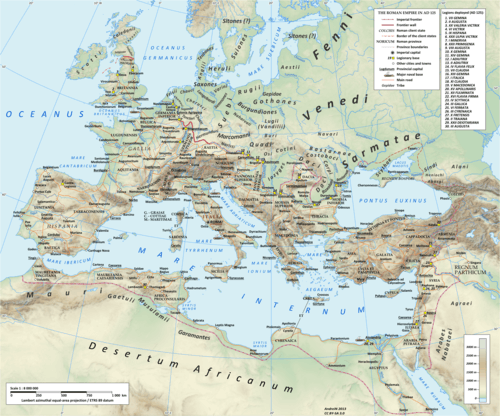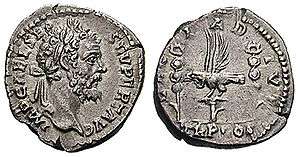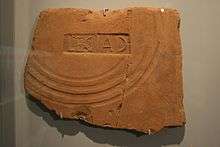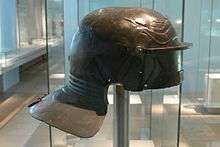Legio I Adiutrix
Legio prima adiutrix ("Rescuer First Legion"), was a legion of the Imperial Roman army founded in AD 68, possibly by Galba when he rebelled against emperor Nero (r. 54–68). The last record mentioning the Adiutrix is in 344, when it was stationed at Brigetio (modern Szőny), in the Roman province of Pannonia. The emblem of the legion was a capricorn,[1] used along with the winged horse Pegasus, on the helmets the symbol used by I Adiutrix legionaries was a dolphin.[1]



Origins
The legion probably originated from the I Classica, a legion levied by Nero among the marines of the Classis Misenensis, but was later completed by Galba. The legion was stationed near Rome.
Year of the Four Emperors
In the confusing Year of the Four Emperors, the legion fought in Otho's army in the Battle of Bedriacum, where this emperor was defeated by Vitellius[2] The victorious Vitellius ordered the legion transferred to Spain,[3] but by the year 70 it was fighting in the Batavian rebellion.

Stationed in Moguntiacum
The city of Moguntiacum (Mainz) is the legion's first known base camp, shared with Legio XIV Gemina, where they attended mainly building activities. In 83, they fought the Germanic wars against the Chatti, a German tribe living across the Rhine, under the command of Emperor Domitian. After that they were transferred to the Danubian army stationed in the Roman province of Pannonia, to fight the Dacians.
Legio I Adiutrix Pia Fidelis
Following the murder of Domitian in 96, the Adiutrix, along with the Danubian army, played an important role in Roman politics, forcing Nerva to adopt Trajan as his successor. When Trajan became emperor, he gave the legion the cognomen Pia Fidelis ("loyal and faithful") to acknowledge their support.[4] Between 101 and 106, under the new emperor's command, I Adiutrix, along with IV Flavia Felix and XIII Gemina, conquered Dacia and occupied the newly formed province. Trajan also used his Pia Fidelis in the campaign against Parthia (115–117), but they were sent back to Pannonia by his successor emperor Hadrian, with base in Brigetio.
During the next decades, I Adiutrix remained in the Danube frontier. Under Marcus Aurelius, I Adiutrix fought the war against Marcomanni commanded by Marcus Valerius Maximianus. Between 171 and 175, the commander was Pertinax, emperor for a brief period in 193. When Septimius Severus became emperor, I Adiutrix was among his supporters, following him in the march for Rome.
In the next decades, the main base was again Pannonia, but they played a part in several Parthian wars, namely the campaigns of 195 and 197–198 of Septimius Severus, 215–217 led by Caracalla and 244 by Gordian III.
It (probably vexilationes of it) took part in the battle of Mediolanum.
The legion received the cognomen Pia Fidelis Bis ("twice loyal and faithful") and Constans ("reliable"), sometime in the 3rd century.
Gabara the Giant
Gabara was a three-meter (9 feet 9 inches) tall Arabian giant that, according to the historian Pliny the Elder, served in the Adiutrix legion under the Roman emperor Claudius. According to the story, Gabara was so admired by his fellow soldiers that some worshipped him like a god.[5]
Attested members
| Name | Rank | Time frame | Province | Source |
|---|---|---|---|---|
| Orfidius Benignus | legatus | 69 | Italia | Tacitus, Histories, ii.43 |
| Sextus Octavius Fronto | legatus | between 75 and 85 | ||
| Titus Julius Maximus Manlianus | legatus | c. 105 | CIL XII, 3167 | |
| Lucius Attius Macro | legatus | between 125 and 130 | CIL III, 4356 | |
| Claudius Maximus[6] | legatus | c. 134 - c. 137 | ||
| Titus Flavius Longinus[7] | legatus | c. 143-c. 146 | Germania | IGRR I, 622 |
| Gaius Julius Commodus Orfitianus[7] | legatus | c. 149-c. 152 | Germania | |
| Publius Helvius Pertinax[7] | legatus | c. 171-175 | Germania | Augustan History, Pertinax, 2.6 |
| Marcus Valerius Maximianus[7] | legatus | c. 179 | Germania | AE 1956, 124 |
| Lucius Aurelius Gallus[8] | legatus | c. 193 | Germania | |
| Gaius Junius Faustinus Placidus Postumianus[8] | legatus | c. 196? | Germania | CIL VIII, 597 |
| Quintus Cornelius Valens Cu[...] Honestianus Junianus[8] | legatus | 200/210 | Germania | CIL VIII, 18269 |
| Claudius Piso[8] | legatus | c. 207 | Germania | |
| Lucius Julius Apronius Maenius Pius Salamallianus[8] | legatus | 220/222 | Germania | CIL VIII, 18270 |
| Aemillus Deciminus | medicus ordinarius | c.114 | Pannonia | CIL III, 4279 |
| Quintus T.f. Attius Priscus | tribunus angusticlavius | 1st century | CIL V, 7425 = ILS 2720 | |
| Lucius Minicius Natalis Quadronius Verus | tribunus laticlavius | c. 115 | CIL XIV, 3599 | |
| Gaius Caesonius Macer Rufinianus | tribunus laticlavius | between 178 and 180 | Germania | CIL XIV, 3900 |
| Gaius Julius Septimius Castinus | tribunus laticlavius | late 2nd century | Germania | CIL III, 10473 |
See also
Notes
- L.J.F. Keppie, The Origins and Early History of the Second Augustan Legion, in L.J.F. Keppie, Legions and Veterans: Roman Army Papers 1971-2000, Stuttgart, 2000, p. 128.
- Tac., Hist. II 43.1.
- Tac., Hist. III 44.
- ILS 1029, 1061, etc.
- Parkhurst, John (1823). A Hebrew and English Lexicon, without points. London: William Banes and Son. p. 21.
- Géza Alföldy, Konsulat und Senatorenstand unter der Antoninen (Bonn: Rudolf Habelt Verlag 1977), p. 334
- Alföldy, Konsulat und Senatorenstand unter der Antonine, p. 296
- Paul M. M. Leunissen, Konsuln und Konsulare in der Zeit von Commodus bis Severus Alexander (1989), p. 335
References
Primary sources
- Tacitus, Histories.
Secondary sources
- J.B. Campbell, art. Legio, in NP 7 (1999), klm. 7-22.
- L.J.F. Keppie, The Origins and Early History of the Second Augustan Legion, in L.J.F. Keppie, Legions and Veterans: Roman Army Papers 1971-2000, Stuttgart, 2000, pp. 123–160.
